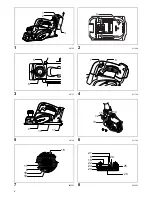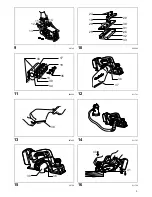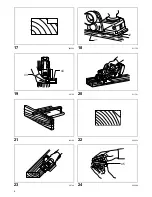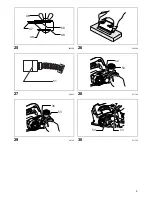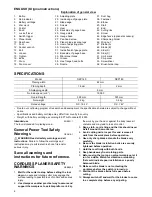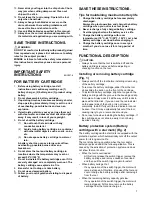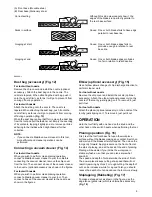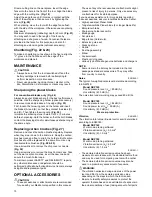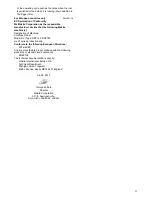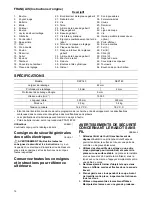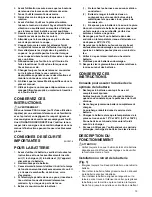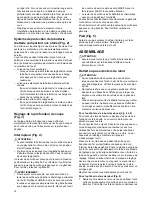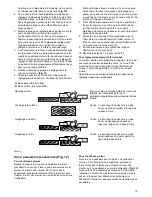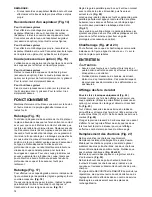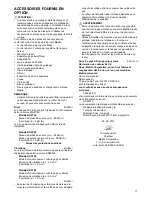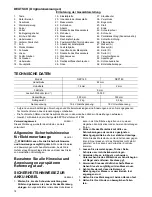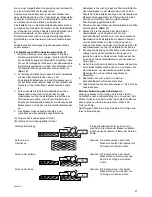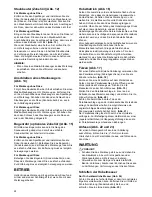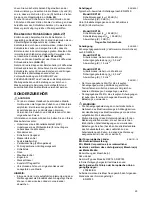
8
Adjusting depth of cut (Fig. 3)
Depth of cut may be adjusted by simply turning the knob
on the front of the tool so that the pointer points the
desired depth of cut.
Switch action (Fig. 4)
CAUTION:
• Before installing the battery cartridge into the tool,
always check to see that the switch trigger actuates
properly and returns to the “OFF” position when
released.
• Do not pull the switch trigger hard without pressing the
lock-off lever. This can cause switch breakage.
To prevent the switch trigger from being accidentally
pulled, a lock-off lever is provided. To start the tool, slide
the lock-off lever and pull the switch trigger. Release the
switch trigger to stop.
WARNING:
• For your safety, this tool is equipped with lock-off lever
which prevents the tool from unintended starting.
NEVER use the tool if it runs when you simply pull the
switch trigger without pressing the lock-off lever.
Return tool a MAKITA service center for proper repairs
BEFORE further usage.
• NEVER tape down or defeat purpose and function of
lock-off lever.
To prevent the switch trigger from being accidentally
pulled, a lock-off button is provided.
To start the tool, depress the lock-off button and pull the
switch trigger. Release the switch trigger to stop.
Foot (Fig. 5)
After a cutting operation, raise the back side of the tool
and a foot comes under the level of the rear base. This
prevents the tool blades to be damaged.
ASSEMBLY
CAUTION:
• Always be sure that the tool is switched off and the
battery cartridge is removed before carrying out any
work on the tool.
Removing or installing planer blades
CAUTION:
• Tighten the blade installation bolts carefully when
attaching the blades to the tool. A loose installation bolt
can be dangerous. Always check to see they are
tightened securely.
• Handle the blades very carefully. Use gloves or rags to
protect your fingers or hands when removing or
installing the blades.
• Use only the Makita wrench provided to remove or
install the blades. Failure to do so may result in
overtightening or insufficient tightening of the
installation bolts. This could cause an injury.
For tool with conventional planer blades (Fig. 6 - 8)
To remove the blades on the drum, unscrew the
installation bolts with the socket wrench. The drum cover
comes off together with the blades.
To install the blades, first clean out all chips or foreign
matter adhering to the drum or blades. Use blades of the
same dimensions and weight, or drum oscillation/vibration
will result, causing poor planing action and, eventually,
tool breakdown.
Place the blade on the gauge base so that the blade edge
is perfectly flush with the inside edge of the gauge plate.
Place the adjusting plate on the blade, then simply press
in the heel of the adjusting plate flush with the back side of
the gauge base and tighten two screws on the adjusting
plate. Now slip the heel of the adjusting plate into the
drum groove, then fit the drum cover on it. Tighten all the
installation bolts evenly and alternately with the socket
wrench.
Repeat the above procedures for the other blade.
For tool with mini planer blades (Fig. 9)
1. Remove the existing blade, if the tool has been in use,
carefully clean the drum surfaces and the drum cover.
To remove the blades on the drum, unscrew the three
installation bolts with the socket wrench. The drum
cover comes off together with the blades.
(Fig. 10)
2. To install the blades, loosely attach the adjusting plate
to the set plate with the pan head screws and set the
mini planer blade on the gauge base so that the
cutting edge of the blade is perfectly flush with the
inside flank of the gauge plate.
3. Set the adjusting plate/set plate on the gauge base so
that the planer blade locating lugs on the set plate rest
in the mini planer blade groove, then press in the heel
of the adjusting plate flush with the back side of the
gauge base and tighten the pan head screws.
4. It is important that the blade sits flush with the inside
flank of the gauge plate, the planer blade locating lugs
sit in the blade groove and the heel of the adjusting
plate is flush with the back side of the gauge base.
Check this alignment carefully to ensure uniform
cutting.
5. Slip the heel of the adjusting plate into the groove of
the drum.
(Fig. 11)
6. Set the drum cover over the adjusting plate/set plate
and screw in the three hex flange head bolts so that a
gap exists between the drum and the set plate to slide
the mini planer blade into position. The blade will be
positioned by the planer blade locating lugs on the set
plate.
7. The blade’s lengthwise adjustment will need to be
manually positioned so that the blade ends are clear
and equidistant from the housing on one side and the
metal bracket on the other.
8. Tighten the three hex flange head bolts (with the
socket wrench provided) and rotate the drum to check
clearances between the blade ends and the tool body.
9. Check the three hex flange head bolts for final
tightness.
10. Repeat procedures 1 - 9 for the other blade.
For the correct planer blade setting
Your planing surface will end up rough and uneven,
unless the blade is set properly and securely. The blade
must be mounted so that the cutting edge is absolutely
level, that is, parallel to the surface of the rear base.
Refer to some examples below for proper and improper
settings.
Содержание BKP140
Страница 4: ...4 17 002580 18 011752 19 011760 20 011761 21 010183 22 003634 23 011748 24 002588 21 42 43 44 45 ...
Страница 5: ...5 25 002589 26 002590 27 001145 28 011749 29 011753 30 011750 46 47 48 49 50 51 52 53 36 53 54 53 ...
Страница 62: ...62 ...
Страница 63: ...63 ...
Страница 64: ...ALA Makita Corporation Anjo Aichi Japan 885273A991 www makita com ...


